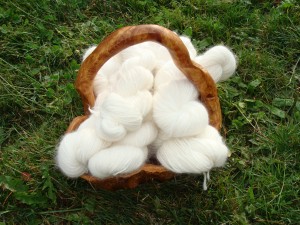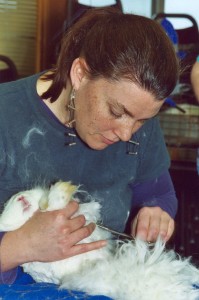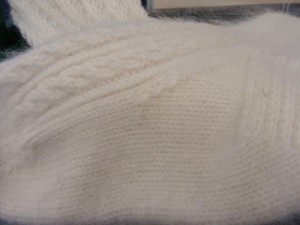What exactly goes into a single skein of yarn? The entire process is extensive. The breeder must successfully breed and raise a sufficient number of Angora rabbits. The rabbit isn’t ready for breeding until after 6 months of age. Shearing of the rabbit occurs in 90-day intervals. The harvested wool is then sorted, washed, and shipped to a processing mill where it is combined with other fibers to create a strong and durable product. Once the yarn comes back from the mill it is washed and dried. Some of the yarn is dyed different colors. Finally, the yarn is labeled.
The process of turning a raw fiber into a finished product that is ready for your knitting needles is a complex process that many are not aware of. The work that goes into one skein of yarn is much more intricate than the work that goes into making a skein of acrylic yarn. Even though a yarn made of luxurious natural fibers is more expensive than a yarn made of synthetic fibers it is much more durable, warmer, softer, and sustainable. What makes the domestically produced IAGARB co-op yarn different from other yarn is its durability, softness, ability to maintain good stitch definition, and limited shedding.
Let’s Break It Down
Introduction
It is the long hair that gives the Angora rabbit its distinctive appearance and places it among the distinguished luxury fibers such as cashmere, mohair, alpaca, and merino. It is considered a luxury fiber due to its low density (this makes garments light yet warm) and softness. The coat of an Angora contains fine hairs and coarse hairs, or bristles. Traditionally, bristles have been advantageous because it prevents felting and creates the yarn’s halo, or fluffiness, effect. Today, variation in the amount of bristle percentage is frequently characteristic of the different varieties of Angora rabbits. These varieties include the English, Russian, British, Giant, French, Chinese, and German. The German Angora rabbit has the lowest percentage of bristle.
Raising Angora Rabbits
Raising angora rabbits is a different experience compared to raising another breed like the mini rex. The Angora rabbit is not ready for breeding until about 6 months of age. Surprisingly enough, breeding Angora rabbits can be a bit difficult. The German Angora rabbit has been selectively bred for its wool and body, not its reproductive ability. Due to the focus on wool production the size of the litters and the frequency of pregnancy have declined slightly. Babies are also much more fragile. They are much more likely to die within the first couple of weeks than your average kitten or puppy.
Once the baby safely enters adulthood it then must be fed grain and hay every day. The cage must also be regularly cleaned to keep away flies and prevent buildup in the wire cage. During haircuts the rabbits also receive a shot of Ivomec to prevent fur mites that can ruin the Angora wool. Unlike other types of livestock, Angora rabbits remain productive for their entire lifespan. They produce high quality fiber throughout their lives. An old rabbit can produce a quality of wool that is on par with a one year old rabbit.
Shearing the Angora
Angora Rabbits require haircuts every 90 days. They can produce about a pound of wool every 90 days. If they do not receive regular haircuts health complications may arise and the quality of their wool becomes unusable. A common health complication is wool block. The rabbit stops eating food because of the blocked gastrointestinal tract. Basically, the rabbit can die due to malnourishment if the wool block goes untreated. Depending on the climate the rabbit may also suffer from heat stroke. The quality of the fiber is also at risk after 90 days. The wool becomes matted and dirty. The vast amount of wool on the body may also prevent the rabbit from being able to clean his rear. Feces begin to collect around the genitals. This becomes a prime breeding ground for flies. It’s important to maintain a regular shearing schedule for your rabbit.
Everyone has their own shearing style. Some like scissors while others prefer clippers. Ask us about upcoming IAGARB shearing parties for opportunities on learning how others shear their rabbits.
German Angoras are never plucked. Their wool is different from other varieties of Angoras in that the wool grows uniformly. In France the Angora rabbit is usually plucked with the assistance of a depilatory mix, which helps release the hair follicles.
China vs. America
The Chinese Angora has also been bred to produce vast amounts of wool, but is not as efficient as the German Angora and has the highest bristle count of the varieties. The Chinese Angora was bred for high bristle count because of problems with felting and the processing of the fiber. High bristle count creates a product that is not suited for next to skin wear. Germany on the other hand, produced a rabbit that has optimal wool for next to skin wear (Schlink and Liu 2003:17).
It was essentially economic conditions in addition to environmental conditions that created the German Angora rabbit. The other varieties cannot compete with its wool yield. However, China attempts to compete with the German Angora rabbit by flooding the market with as much Angora as possible. Commercial farms in China can house over 10,000 does and each employee is responsible for around 500 rabbits. Employees are encouraged to take 10-15 minutes to shear each rabbit compared to the American method that takes anywhere from 30 minutes to over 60 minutes (Schlink and Liu 2003:14).
Due to the time limit for commercial farms in China the Angora comes in many different grades or quality. The wool used in garments is often short and of varying lengths. This has propelled the belief that Angora sheds excessively. The Angora produced in America is a more uniform product due to the extra time that is taken to ensure a better grade of wool. As a result, IAGARB co-op yarn has very little shedding and a longer lifespan than Angora garments that come from China.
Preparing Wool For Processing
Once the wool is shorn we have to sort through it to ensure that the wool being shipped to a processing mill is of premium quality. We remove any foliage, mats, second cuts, or short wool. If the Angora is dirty we hand wash it.
Processing The Wool
IAGARB has set up a co-op so that members from around the country can add their wool to a large yarn run. The wool is shipped to Zeilinger Wool Co. in Michigan for processing. It is important to find a good processing mill that can handle Angora wool. Angora tends to be very tough on the processing machines. During processing the Angora is combined with Merino and/or nylon, depending on whether the yarn run is for socks (50% Angora, 30 % nylon, 20% superwash Merino) or not (85% Angora, 15% Merino). Once the yarn is finished it is then shipped to each IAGARB member who contributed raw Angora to the yarn run.
Preparing The Yarn For Selling
When the yarn returns from the mill it needs a lot of preparation if it is going to sell. Initially, the yarn has no halo and looks like cotton string. We wash each skein of yarn to remove any dirt or oil that has accumulated from processing. The yarn is then dried briefly in the drier on the delicate setting to give it some fluff and halo that is characteristic of Angora. It is then placed outdoors to finish drying.

Angora yarn that has been washed and dried after receiving it from the mill. © Windsor Farms Rabbitry
Some of the yarn is dyed various colors. This yarn is set aside and sent to a local artisan who uses various dye colors to create a multidimensional yarn that appeals to those who want fancy colorful socks. After all of the yarn is dried and dyed it then has to be labeled for selling. Once all of this is completed the yarn is ready for knitting.


